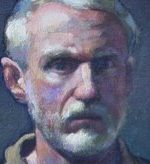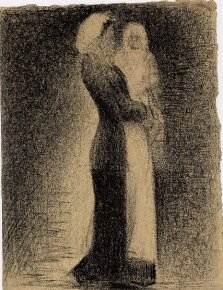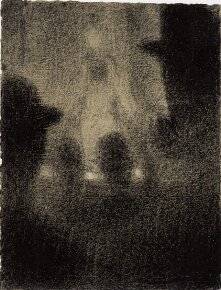mission impossible?
SAVING THE VISUAL ARTS

by
JOHN M. GORDON
John
M. Gordon received his MFA degree in painting from the
University of Wisconsin in 1966, where he studied under Dean
Meeker in printmaking, Santos Zingale and Milton Resnick in
painting, and John Wilde in drawing. Since then he has taught
drawing and painting to over 1500 private students and over
2000 correspondence students in 20 countries. He currently teaches
drawing and design at St. Norbert College in DePere, Wisconsin.
For further information, visit John's website: www.newmasters.com
___________________
This
article is directed to artists, art educators and appreciators
who are concerned about the increasing trivialization and irrelevance
in the field, its lack of defining characteristics, its alienation
as an academic discipline from the greater intellectual community
and the resulting failure of art education to maintain a significant
presence in the curricula of American schools.
Art is whatever I
say it is. --Marcel Duchamp
Art is nothing. --Flavio
Sciole
DIRECT-PERCEPTION:
TOWARDS AN OBJECTIVE FOUNDATION FOR THE VISUAL ARTS
After
nearly a century, modern and postmodern artists, critics and
art educators have so liberated the term art from its traditional
meanings and applications that in both the popular and professional
senses of the term, it has lost its capacity to function as
a word – that is it can no longer distinguish itself from
what it is not. In both theory and practice, art is anything
one chooses to make it; an artist is anyone who makes the claim.
The lack of focus of the visual arts is due not only to its
theoretical ambiguity but to its related lack of instructional
coherence and measurability. It can be safely stated that art
education is the only performance-based field of study that
has neither a viable system of standards nor an established
technical foundation. It is a field with no clearly defined,
generally accepted goals, no established methodologies and no
meaningful way to measure the progress of its students.
A
field that fails to maintain its technical base and is at war
with itself on the very issues that define it -- on its very
nature and purpose -- is a field in crisis. The resolution of
that crisis will require foundational changes in the way art
is thought about, produced and taught.
I
will attempt to make the case that in both the visual arts generally
and art education specifically, the cause of decline is the
same: the neglect of direct-perception drawing and painting
-- rendering what one sees as one sees it, in the immediate
present, without recourse to memorized formulae or the influence
of other artists' styles. This practice, which had been the
pedagogical foundation (although seldom the direction) of the
field from the Renaissance to the turn of the 20th Century,
was overturned in a matter of three or four decades by the abstraction-based
modern art and art education movements.
There
are two reasons why the visual arts field abandoned its technical
traditions in both the practice and teaching of art over the
past century. The first is its acceptance of the modernist notion
that the imposition of technical rules inhibits creativity.
The second is that art education came under the influence of
the progressive movement, as did education generally, which
advocated turning away from the teaching methods and goals of
the past and embracing speculative experimentation as a means
for educational reform. These trends, in company with the abandonment
of strict performance standards in the foundational skill of
drawing, destroyed the technical consensus that had held the
field together since the early Renaissance.
It
is for this reason that "the elements and principles of
design" have been the only theoretical constant in the
field for the past 70 years and why those principles -- balance,
unity, movement, proportion, rhythm etc. -- have become almost
meaningless. They are meaningless as currently applied because
they are not supported, as are the principles of music education
and sports training, by rigorous performance standards -- and
are generally not binding. In practice, they are not really
principles at all but loosely defined tools of personal expression
that are available to the artist and the teacher who may use
them as they wish, break them as they wish and ignore them as
they wish. It should be obvious that no new pedagogy worthy
of the name -- and certainly none that would be accepted field-wide
-- can be developed within the current modernist/postmodernist
theoretical framework. This is not to suggest that all art teachers
and art departments fail to emphasize accurate drawing, but
those that do are exceptional and do not significantly influence
the field.
 The
departure of the art education field from its strict adherence
to visual truth in the training of artists was theory driven
and intentional, facilitated by two dominant instructional stretegies:
encouraging students to draw and paint abstractly -- to willfully
distort or abandon perceived imagery -- and encouraging them
to adopt the stylistic characteristics of other artists. So
at its very outset, the modern art education movement was fatally
conflicted between its intentions and its methods. It adopted
the abstraction principle for purposes of self-expression (and
as a political weapon against traditional art institutions and
practices). It adopted its mannerist teaching techniques out
of necessity. Most new art students had difficulty comprehending
abstraction in principle and were generally not inclined toward
it in practice. Their reluctance was understandable: willful
abstraction is counter-intuitive and un-natural by definition.
The
departure of the art education field from its strict adherence
to visual truth in the training of artists was theory driven
and intentional, facilitated by two dominant instructional stretegies:
encouraging students to draw and paint abstractly -- to willfully
distort or abandon perceived imagery -- and encouraging them
to adopt the stylistic characteristics of other artists. So
at its very outset, the modern art education movement was fatally
conflicted between its intentions and its methods. It adopted
the abstraction principle for purposes of self-expression (and
as a political weapon against traditional art institutions and
practices). It adopted its mannerist teaching techniques out
of necessity. Most new art students had difficulty comprehending
abstraction in principle and were generally not inclined toward
it in practice. Their reluctance was understandable: willful
abstraction is counter-intuitive and un-natural by definition.
To
get students to draw and paint abstractly, teachers first had
to convert them to the ideology of self-expression, then to
the companion idea that self-expression required abstraction.
The gist of the message was this:
The
modernists further assumed that the self is autonomous and foundational
and that individual artists have the potential to plumb the
depths of Being to reveal universal truths of benefit to us
all (the genius theory). The postmodernists disagreed. There
is no autonomous self; there are no Universals; there is no
Truth. The individual is a social construct. Art is political.
In
any case, this directive to express the self through absraction
created a pedagogical problem that has never been satisfactorily
resolved: teaching students how to draw and paint something
that they do not see and cannot visualize. The problem was solved
on the instructional side by pre-programming the visualization
process, which is to say, by showing students examples of abstract
drawings and paintings. However, this practice created another
problem on the learning side: that of originality. How do students
who gain their understanding of abstraction by looking at other
artists' abstract pictures, create their own pictures without
mimicking those examples? The answer, as every art teacher knows
(but few will admit) is that they cannot. This is true, not
only of newly-initiated art students, but of accomplished abstractionists
as well. Picasso and Braque, during their early Cubist period,
made regular visits to each other's studios and ended up producing
pictures so similar that they were later unable to identify
them as their own.
In
order to follow the new path of mannerist abstraction with at
least the appearance of a clear conscience, artists and teachers
had to deny the obvious: that the practice of mimicry is contradictory
to creativity -- and to boldly advocate its use as an important
part of the creative process. One does not mimic, one is influenced
or inspired by the work of others. This is now a thoroughly
institutionalized notion which has yet to be seriously challenged,
although a theoretical basis for such a challenge has been on
the table for over 2000 years.
"The
imagination cannot create,
it is composed of memories." -- Aristotle
 Aristotle
may be overstating his case, but the dependence of the imagination
on memory cannot be refuted. Whatever else may be happening
in the imagining process: mixing, exaggerating, simplifying,
distorting, etc. -- and a case can be made that some sort of
(non-original) creativity is involved in these activities --
memory is the primary source of the material on which it is
working. More importantly -- and this gets to the very heart
of the problem with imaginary invention and modern art generally
-- the dominant content of memory for the artist, with respect
to its mental staying power and retrievability, is the work
of other artists.
Aristotle
may be overstating his case, but the dependence of the imagination
on memory cannot be refuted. Whatever else may be happening
in the imagining process: mixing, exaggerating, simplifying,
distorting, etc. -- and a case can be made that some sort of
(non-original) creativity is involved in these activities --
memory is the primary source of the material on which it is
working. More importantly -- and this gets to the very heart
of the problem with imaginary invention and modern art generally
-- the dominant content of memory for the artist, with respect
to its mental staying power and retrievability, is the work
of other artists.
The
Picasso/Braque episode is a case in point, which I make, not
to repudiate imaginative art, but to establish the foundational
importance of perceptual drawing and painting -- both as ends
in themselves and (secondarily) as a foundation for invention.
The best imaginative artists (Picasso, Matisse, Dali etc.) were
classically trained. Although it is not possible to be clinically
specific about the relationship between classical training and
imaginative creativity, one can assume that those trained to
see real objects with the eye and render them with the hand
have a broader range of memories, better memorial access and
better manual response to input from either the eyes or the
memory than those who learn to draw only from their memories
of other people's pictures.
As
a teacher in his Académie Matisse (Paris), abstractionist
Henri Matisse insisted on strict visual accuracy from his beginning
students. "Many of the students, knowing Matisse only through
his work, expected to find that they could do just what they
liked in his classes. On the very first morning, for instance,
they welcomed him by festooning the classroom with canvases
daubed in the loudest, strongest colors on their palettes. Matisse,
walking in, exclaimed, 'What's all this rubbish? Take it down
at once!' Then he put them through a series of academic exercises
that must have made some of them wish they were back in the
Beaux-Arts. He insisted on exact measurements and on the use
of the ruler and the plumb line." (John Russell, The
World of Matisse, Time-Life Books, 1969.)
The
common assumption that creativity is exclusively a function
of the imagination fails to take into account the superior and
more fundamental creativity of perception. Researchers in the
perceptual sciences -- like Charles Solley and Gardner Murphy
(Development of the Perceptual World, 2006, Kessinger
Publishing, 2006) -- are in general agreement that seeing is
not, as commonly assumed, a straight-forward, purely receptive
process. We do not see and then think about and have feelings
about what we saw. Thinking and feeling are part of the perceptual
process. What we actually experience as a result of looking
at a tree or an apple on a plate is not the tree or the apple,
but a percept, a picture in our own brains. This picture is
formed in the visual cortex at the back of the brain, and is
only partially composed of retinal data (which is already pre-filtered
to admit only a portion of what is actually out there). This
remaining retinal data is combined with the memories of past
perceptual, intellectual and emotional experiences into an image
that we mistakenly assume to represent the outside world. In
fact, it is a composite of two worlds: the external and the
internal, the present and the past. So to abstract -- to willfully
distort or ignore the images of direct experience -- is to depart,
not only from the world at large, but from ourselves as individuals.
Thus it can be argued against the self-expressive assertions
of abstractionism that the most creative human function is seeing
and the most self-expressive artistic act is painting truthfully
what one sees.
The
most serious problem with art programs based on the invention
principle is that they have no objective basis for claiming
creativity or developmental value or for judging their own effectiveness
or the progress of their students. Teachers in such programs
cannot determine how successful their students are at working
from their imaginations because they have no way of knowing
what their students' imaginations actually contain. The only
imagination teachers have any direct knowledge of is their own
-- which explains why art instruction today is so heavily influenced
by the personal tastes of the instructor and why such programs
vary so widely from school to school. Perception-based art instruction,
on the other hand, draws upon objective rather than personal
references: the objects of the visible world. Whether the subject
is a simple cartoon picture or a complex still life, the teacher
and the student can judge the student's performance by simply
comparing his or her artwork to the original -- something they
both experience in common.
To
advocate for direct-perception in the training and practice
of art is to confront the inadequacies and ambiguities of the
language of art theory, both traditional and contemporary. The
practice of perceptual drawing and painting does not fit any
of the commonly used terms relating to recognizable imagery.
Representational art, figurative art, realism etc. refer to
what a picture looks like. They imply nothing about the methods
used or the artist's intentions in making it. A realistic picture
can be done entirely from memory, formulae (steps that one follows
to make trees look like trees, clouds like clouds) or photographs.
A direct-perception
picture is done for the purpose of gaining perceptual knowledge
and improving one's manual response to that knowledge -- to
learn to see more clearly and substantially and to paint more
truthfully and skillfully. The goal of realism is precisely
the opposite; its purpose is to create convincing illusions.
This difference in intent is reflected in the way the products
of the two methodologies are evaluated. The technical success
of direct-perception is measured against the actual object perceived,
while the success of realism is measured against prevailing
conventions -- by how well it satisfies the pictorial expectations
of the general public.
Although
direct-perception is process-centered by definition, the argument
for adopting it as the guiding principle of art and art education
also rests on the quality of the product, about which I will
make the following general claim: No picture produced by image-making
or image-bending technology, painted from the imagination, by
formula or by means of the willful approbation of the styles
and imagery of other artists can surpass the quality, subtlety
and depth of feeling of a truthful, skillfully hand-rendered
picture done directly from life. And nothing in the field could
be more personally beneficial and fulfilling than acquiring
the skills and personal qualities necessary to draw or paint
such a picture.
There
is no objective way to prove this claim of course, but it is
self-evidently true to those who have experienced it personally,
either as artists or appreciators. It can also be supported
by reference to those inexplicable, but almost always significant,
occasions in art history when perception was pursued for its
own sake (as opposed to being used for the illustrative or decorative
purposes of the day): Leonardo's Mona Lisa, Rembrandt's self-portraits,
Velazquez's portrait of Phillip IV, Gericault's Madwoman, Monet's
haystacks, and the "incredible apples and pears by Paul
Cezanne" (from Woody Allen’s Manhattan).
I cite these artists, not to advocate a return to the art and
theories of the past, but to make a case for a return, with
new eyes, to the realities of the present.
This
will not be an easy case to make. It is one thing to advocate
for direct-perception as an instructional tool; it is quite
another to advocate it as an aesthetic direction. One of the
problems is that direct-perception and realism, while theoretically
opposed, are formally indistinguishable. Another is the early
modernists' misappropriation of Paul Cezanne as a fellow abstractionist
when in fact he was a dedicated champion of direct-perception.
But these problems are beyond the scope of this article and
are not central to its point: that direct-perception is the
inescapable foundation of the visual arts, is responsible for
most of the celebrated masterpieces in art history, and is the
only conceivable option left open to us.